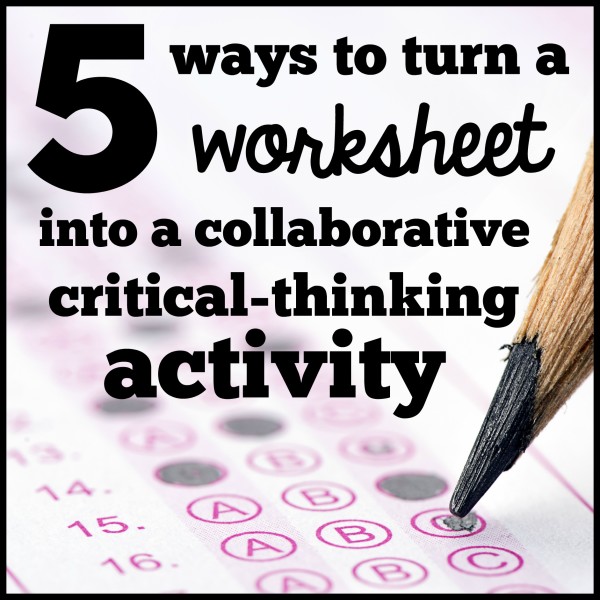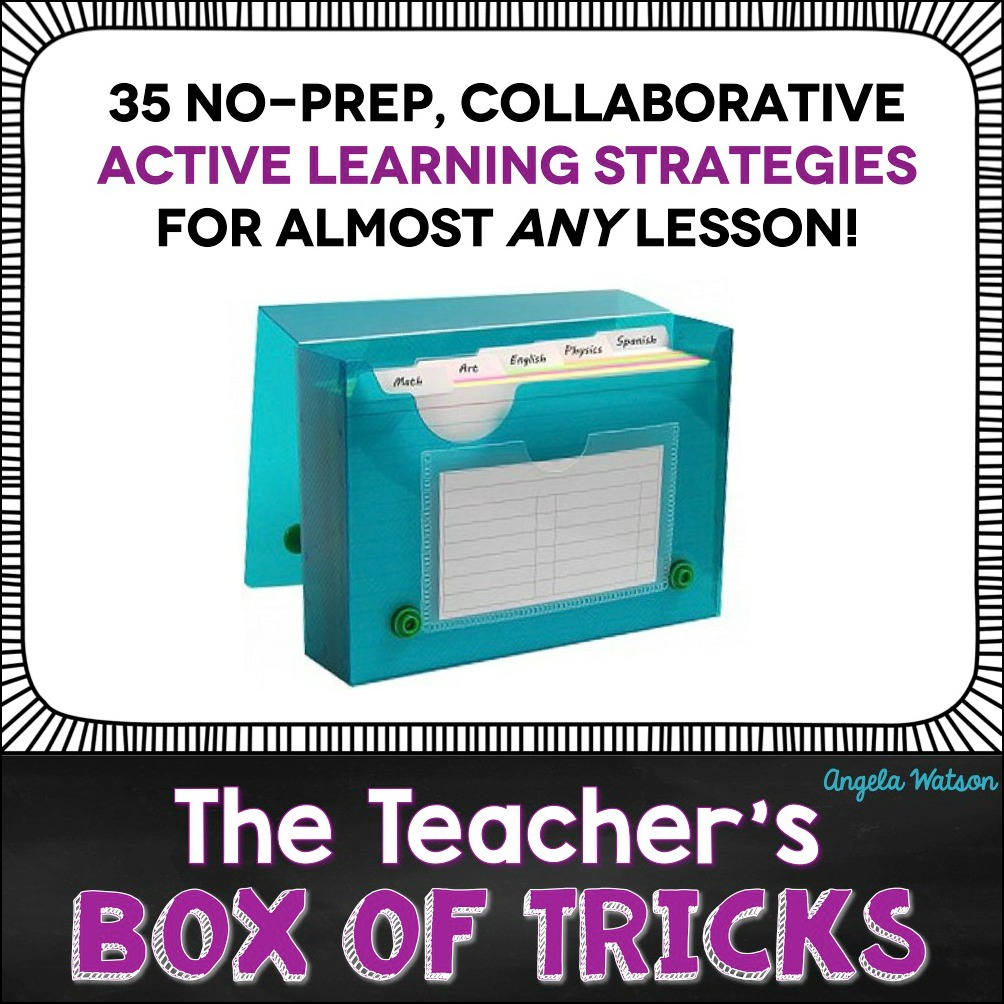Worksheets: we all have to give them, we all hate doing it.
Here are 5 no prep ways you can turn just about any lower-level thinking or rote practice worksheet (like a multiple-choice or fill-in-the-blank quiz, or math drill workbook page) into an activity that’s collaborative and includes higher-level thinking skills.
The strategies work for grades 3-12 (and can be modified for students who aren’t yet reading/writing independently). The best part? The activities are engaging for kids and FUN.
These 5 active learning strategies and games have absolutely saved me and my third graders when I was required to give yet ANOTHER test prep activity:

1) Cut Apart
Group students into teams of five and pass out one copy of the same worksheet to each group. Have the group cut apart the worksheet so each question is on a separate strip or “card.” Students then place the stack face down and choose roles (to be Person 1,2,3,4, or 5.)
Explain how the activity is played and write the following team roles on the board for class reference: Person 1 on each team chooses a card and reads the question or problem aloud to the team. Person 2 paraphrases the question and/or offers clues to the answer. Person 3 says the answer and explains his or her thinking. Person 4 explains why he or she agrees or disagrees.
Person 5 places the question card in one of two piles, Agree or Disagree, and then takes on the role of Person 1 for a new “round” of play and reads the next question. (Person 1 now becomes Person 2, and so on. Because there are an odd number of people on each team, the roles–1,2,3,4 and 5–will shift for each question so that everyone gets a turn to play each role.)
Also try:
- simplifying the concept by having 4 people on a team (eliminating Person 5’s role) and having each person retain the same role for 2-4 minutes, switching to a new role when you give a signal
- providing time at the end for each group to go back through their “disagree” pile of questions and come to a consensus, either within the group or by reading the question aloud to the class and having other teams share their thoughts
2) Everybody Knows
Divide students up into teams of 4, and number them off so each person plays the role of Team Member 1,2,3, or 4. Ask a question from the worksheet and provide 30-60 seconds for each group to agree upon an answer. They should ensure every person on the team understands the reasoning, as they won’t know which team member will be responsible for answering the question. Then, randomly call out a number between 1 and 4.
The person on each team whose number was called writes his or her answer on an individual dry erase board (or sheet of paper). Team members can NOT help in any way, or they will lose a point. On your signal, the designated student holds up his or her board/paper to show the answer, and you (or a student volunteer) can award and record points on the board. When time is up, the team with the most points wins.
Also try:
- setting a goal for each team to earn at least X amount of points (perhaps 5 or 10, depending on how long you plan to play the game), and continue playing until every team has met their goal and the whole class has experienced success
3) Lines of Communication
Have students stand in two rows facing each other. Choose a question or problem from a worksheet and read it aloud to the class. Give students 30-60 seconds to discuss their responses and reasoning with the person across from them. Give a signal for each student to then move one position to the right (the student without a partner at the end simply walks to the other end to find his or her new partner.) Continue playing until students have discussed all the questions.
Also try:
- giving students an answer, and have them work with their partner to brainstorm possible questions/problems for that answer
4) My Mistake
Challenge students to complete the worksheet and make an intentional error (an incorrect math calculation, out-of-order sequencing, a grammatical or factual mistake in a written response, etc.) Then have students switch papers, mark the mistake, and discuss it.
Also try:
- having students make a larger designated number of errors in their work, such as 5, and challenging their partner to find all the mistakes
- displaying particularly challenging mistakes (or mistakes that demonstrate common student misconceptions) under a document camera, and having the whole class look for the error(s) so you can re-teach and extend student learning
5) Pair Rotation
Group students into pairs, and have them place their desks together in a way that forms a large circle in the classroom (or clearly-defined rows.) Pass out the assignment you want students to complete and have each person in the pair choose to be Partner 1 or Partner 2.
Set a timer for an appropriate amount of time for each pair to complete the first question or problem in the assignment, then sound a signal to let all the Partner 2’s know to move one seat down the row or clockwise while the Partner 1s stay in place. The new partnerships then work together to solve the next problem. Halfway through the assignment, announce that students should switch roles, and now the Partner 1s will rotate while the Partner 2s stay in place.
Also try:
- forming trios, and have Partner 2s rotate clockwise and Partner 3s rotate counter-clockwise
Want more engaging, no prep activities?
If lesson planning is taking you HOURS and yet you feel like all you do is giving boring test prep materials, check out The Teacher’s Box of Tricks. This is a resource I first created for members of The 40 Hour Teacher Workweek Club to help them save time with lesson planning, and I’ve just made it available in my TpT store.
The 5 strategies in this post are part of The Teacher’s Box of Tricks. Why waste time reinventing the wheel and creating all your own activities from scratch?

It takes YEARS for the average classroom teacher to develop a workable set of learning strategies that can be implemented on the spot and adapted intuitively for students’ needs.
The Teacher’s Box of Tricks: a set of go-to active learning strategies that can be implemented (and adapted) on the spot.
Like other experienced teachers, I’ve taught the same concepts and skills to students so many times that I’ve developed a huge repertoire of activities that I can build into my instructional time. I have activities that provide more scaffolding if the kids didn’t really seem to understand the lesson, and activities that will extend student learning if what I taught was too easy. I have activities that will take a long time if my lesson ends early, and activities that can be done quickly if my lesson takes too long.
I call this mental list my teaching “box of tricks,” and I’ve refined it with hundreds of students over the course of the last 15 years. And now for the first time, I’ve written everything down in short, easy-to-follow directions so you can expand YOUR box of tricks immediately!
10 of the ideas will help you turn worksheets into engaging collaborative activities (like the examples in this post).
Another 25 activities are worksheet-free and simply provide an easy way for kids to practice the skills you’ve just taught them (so you can ditch the worksheets and traditional pencil-and-paper activities altogether.)
The ideas in The Teacher’s Box of Tricks:
✓ Are adaptable for ANY subject area
✓ Are adaptable for ANY grade level 3rd and up (modifiable for students who aren’t yet reading/writing independently)
✓ Are totally no-prep: you can choose any activity and be ready to teach it immediately
✓ Require no special materials: you’ll need only basic classroom supplies, like scratch paper and pencils
✓ Allow you to make worksheets more meaningful OR replace them completely with active learning strategies
The box of tricks comes in a list format AND sized to fit a 3×5 index card file box to create a literal box of tricks. Write your own ideas down on index cards and keep adding to your box of tricks over the years!

Angela Watson
Founder and Writer
Discussion
Leave a Reply
OR

Join our
community
of educators
If you are a teacher who is interested in contributing to the Truth for Teachers website, please click here for more information.
















I love these ideas! I am looking for ways to group the students without resistance. I love to have students collaborate but am often met with constant complaints from some, not all students about other members of their group. This really subtracts from the productivity of the activity. It also cuts into the time allotted. I’ll usually have students who are introverted and will politely ask if they can please work alone. It’s hard for me to force them into a group when I can clearly see how uncomfortable they are.
I would truly appreciate suggestions as to how to avoid this. Unfortunately, It’s made me reluctant and a bit stressed when planning collaborative activities.
I teach middle school and welcome suggestions!
I have these exact same concerns with my high schoolers and would love to hear feedback on how to address the concerns. Thank you.
Tell them in real life they cannot choose who to work with. They do not have to like their bosses, nor their coworkers. Hopefully they understand.
Ask yourself if it is necessary for them to work cooperatively for the activity or not. Can they really get enough out of it working alone? Can they work just in pairs? Can they self select partners, or will that prevent the activity from being effective? I am an introvert but while I prefer to work independently I can work with others. However, I’m in my mid-40s and when I reflect on a lifetime of working with others in school and at work, I can confidently say that 90% of the time I get better results working alone. It isn’t just about my comfort level, it is more efficient and saves a tremendous amount of time. So I don’t force my students to work collaboratively except for a few activities where collaboration is really essential to the learning process. I usually give students choice: they may work in a small group, with a partner or independently (this is differentiating instruction for their needs). Because I don’t force work all the time for the sake of following the teacher trend, students respect when I tell them that a particular activity must be completed with others, or when I tell them they need to work with a buddy on field trips, etc.
Great ideas! Thanks so much for sharing them. I’m going to try the “My Mistake” activity tomorrow. =)
Do you have any ideas for primary grades? I just switched from 3rd to 1st. Thanks!